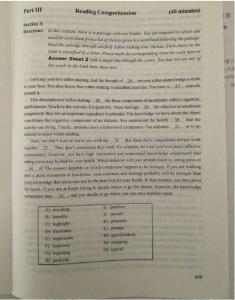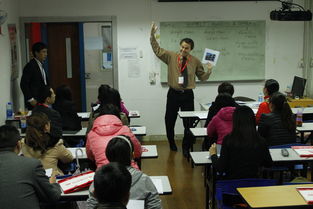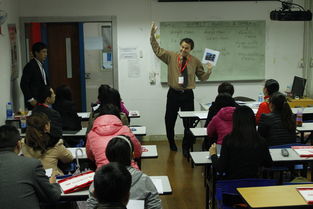2016年6月英语六级选词填空练习题及答案
Section A
Directions: In this section, there is a passage with ten blanks. You are required to select one word for each blank from a list of choices given in a word bank following the passage. Read the passage through carefully before making your choices. Each choice in the bank is identified by a letter. Please mark the corresponding letter for each item on Answer Sheet 2 with a single line through the centre. You may not use any of the words in the bank more than once.
Questions 36 to 45 are based on the following passage.
In the second half of the twentieth century, many countries of the South began to send students to the industrialized countries for further education. They(36)needed supplies of highly trained personnel to(37) a concept of development based on modernization. But many of these students decided to stay on in the developed
countries when they had finished their training.
In the 1960s, some Latin American countries tried to solve this problem by setting up special "return"programs to encourage their professionals to come back home. These programs received support from international bodies such as the International Organization for Migration, which in 1974enabled over 1,60038scientists and technicians to return to Latin America.
In the 1980s and 1990s, "temporary return" programs were set up in order to make the best use of trained personnel(39)strategic positions in the developed countries. This gave rise to the United Nations Development Program's Transfer of Knowledge through Expatriate Nationals, which encourages technicians and scientists to work in their own countries for short periods. But the brain drain from these countries may well increase in(40) to the new laws of the international market in knowledge.
Recent studies (41) that the most developed countries are going to need more and more highly qualified professionals around twice as many as their educational systems will be able to produce, or so it is thought. As a (42)there is an urgent need for developing countries which send students abroad to give(43)to fields where they need competent people to give muscle to their own institutions, instead of encouraging the training of people who may not come back because there are no professional outlets for them. And the countries of the South must not be content with institutional structures that simply take back professionals sent abroad; they must introduce(44)administrative procedures to encourage them to return. If they do not do this, the brain drain is(45)to continue.
A. forecast
B. flexible
C. neutrally
D. preference
E.detachM
F. bound
G. implement
H. consequence
I. qualified
J. dismissing
K. result
L.occupying
M. urgently
N . skeptical
O . response
20世纪下半叶,很多发展中国家开始把本国学生送往工业化国家深造。他们[36]迫切需要大批训练有素的专业人才以[37]落实基于现代化的发展观。
20世纪60年代。一些拉美国家设法通过设立专门的“回归”项目,鼓励其专业人才回国,以使这个问题得到解决。这些项目得到了诸如国际移民组织等国际机构的支持,因此,1974年,1600多位[38]合格的科学家和技术人员得以回到拉丁美洲。
在20世纪80~90年代,“暂时性回归”项目得以设立,旨在使那些在发达国家[39]担任战略性职位的专门人才人尽其用。这也促使联合国发展计划署设立了“外侨传递知识”项目。该项目鼓励技术人员和科学家在自己的祖国进行短期的工作。但是[40] 由于知识界国际市场的新法则,这些国家的人才流失或许会更加严重。
最近的研究[41]预测,最发达的国家将会需要越来越多的高素质专业人才,所需人数大概是其教育系统所能培养的人才的两倍。或者也可以说,人们是这么认为的。[42]因此派学生出国留学的发展中国家急需向那些需要有能力的人来加强其体系的领域[43]倾斜,而不是鼓励培养那些由于找不到专业出路而有可能不回国的人。并且发展中国家不应该只满足于那种简单地把派往海外的专业人才送回国的体制结构,而是必须要引进[44]灵活的管理程序以鼓励留学生回国。如果它们不这样做,人才流失问题[45] 必定会继续存在。
36.M
语法判断:分析句子主干可知,该空前后是一个完整的句子,结合所给选项可知,该空缺少一个副词来修饰后面的谓语动词needed。
语义判断:符合上述语法条件的只有两个选项,neutrally意为“中立地”,urgently意为“迫切地,紧急地”。此处是指“他们迫切需要大批……”,故只有urgently符合文意,故选M。
37.G
语法判断:分析句子主干可知,该空前面是一个完整的句子,这里需要一个动词原形与前面的to构成动词不定式,并和后面的名词concept(理念)一起作前面的宾语personnel(人才)的补足语。
语义判断:符合上述语法条件的有四个选项,forecast意为“预报,预测”,detach意为“分离;使超然”,bound意为“束缚;划定界限”,implement意为“完成,实现”。此处是指“需要大批人才落实(或实现)……发展观”,故只有implement符合文意,故选G。
38.I
语法判断:分析句子主干(which…enable…to returnto…)可知,该空所在的句子是一个由which引导的非限制性定语从句,这里需要一个形容词作定语修饰后面的宾语scientists and technicians(科技人员)。
语义判断:符合上述语法条件的选项有四个,flexible意为“有弹性的;灵活的”,bound意为“受约束的;有义务的”,qualified意为“合格的”,skeptical意为“怀疑的”。结合句意可知,只有quafified(合格的)符合这里的表达。故选I。
39.L
语法判断:分析句子主干可知,该空前面是个完整的句子,这里需要一个现在分词与后面的strategic positions in the developed countries一起作前面的personnel的定语,以补充说明它前面的personnel。
语义判断:符合上述语法条件的选项有两个,dismissin9意为“解雇;解散”,occupyin9意为“占据;任职”。结合句意可知,只有occupying(任职)符合这里的表达,故选L。
40.O
语法判断:分析句子主干可知,该空前面是个完整的句子,即主谓结构(brain drain…increase),主谓结构后面是一个介词短语(in——to the new laws of the international market in knowledge)作状语修饰谓语动词increase。通过分析此短语可知,in和to之间缺少一个名词。

语义判断:符合上述语法条件的选项有四个:preference意为“更喜欢,偏爱”,response意为“反应”,consequence和result意为“结果”。注意到response(&应)构成的介词短语in responseto为常用搭配.意为“对……的反应”,符合句意,因此选项O是正确答案。
41.A
语法判断:分析句子主干可知,该句缺少一个谓语动词,空格后为that引导的宾语从句。
语义判断:结合37题的“语义判断”以及该空后面宾语从句中的将来时态are going to可知,只有动词forecast(预测)符合这里的句意。所以正确答案是A。
42.K
语法判断:分析句子主干可知,该空后面是一个therebe结构的完整句子,判断此处为作状语成分的介词短语as a__________。分析此短语可知,as a后缺少一个单数名词。
语义判断:结合40题的“语义判断”,只有result(结果)构成的介词短语as a result(因此)符合这里的表达.故正确答案是K。
43.D
语法判断:分析句子结构可知,该空所在的位置是一个由which引导的定语从句,修饰前面的countries,而该空和其前的动词9ive一起构成动词不定式结构to give__________to fields where…owninstitutions,作它前面send students abroad的补足语。通过分析短语give__________to可知,空格处应填入一个名词。
语义判断:结合40题和42题的“语义判断”,只有preference(偏爱 )构成的动词短语give preference to(对……偏爱)符合这里的句意,因此D是正确答案。
44.B
语法判断:分析句子主干可知,该空缺少一个形容词,和administrative一起作定语修饰后面的宾语procedures。
语义判断:符合上述语法条件的选项有四个,结合38题的“语义判断”可知,flexible(灵活的)符合这里的句意,因此B是正确答案。
45.F
语法判断:空格前为句子主语brain drain和系动词is,空格后为动词不定式to continue。由此可知,本句的谓语结构不完整。这里缺少一个形容词和is构成系表结构。
语义判断:在剩下的单词中,符合语法条件的选项有:现在分词dismissing和形容词flexible、bound、skeptical。结合38题的“语义判断”和句意可知只有bound符合语境,beboundto为常用搭配,意为“一定,必定”,指人才流失问题必定会继续存在,故选F。
 爱华网
爱华网


